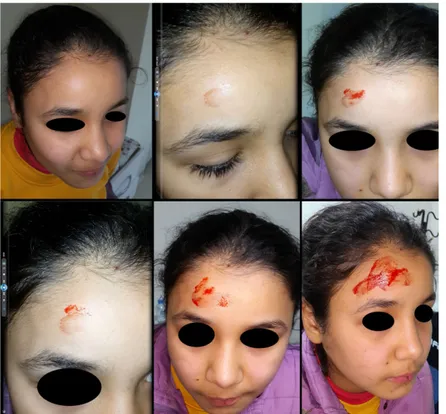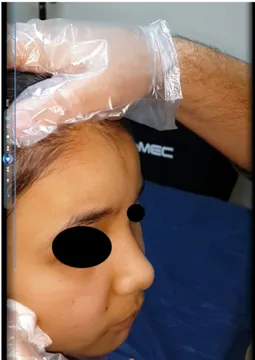Case Report
Hematidrosis on the forehead following trauma: a case report
Yavuz Yes
ßilova
1,
MD, Enver Turan
2,
MD, and Mustafa Aksoy
2,
MD1Department of Dermatology, Special
Lokman Physician Hospital, Van, Turkey, and2Department of Dermatology, Harran
University School of Medicine, Sanliurfa, Turkey
Correspondence Yavuz Yesßilova,MD
Department of Dermatology Special Lokman Physician Hospital 65000 Van
Turkey
E-mail: yavuzyesilova@gmail.com Conflicts of interest: None. doi: 10.1111/ijd.13274
Hematidrosis, also known as hematohydrosis and hemidrosis, is an episodic, rare skin disease in which blood oozes from the sweat glands.1 Although its
etiopathogenesis is not fully known, it is thought to occur in times of emotional or physical stress.2,3 We present an 11-year-old patient diagnosed with hematidrosis on the
Figure 1 Clinical examination of an 11-year-old girl shows bleeding on the right side of the forehead that occurs when the subject moves from a cold to a warm environment
ª 2016 The International Society of Dermatology International Journal of Dermatology 2016 1
right side of the forehead following trauma, who responded to local adrenaline treatment.
Case report
An 11-year-old girl presented at the polyclinic reporting approximately 20 incidences of spontaneous bleeding from the right side of the forehead over the preceding 2 days that occurred when the patient moved from a cold into a warm environment. A detailed history revealed that 1 day before the bleeding started, the patient had fallen out of bed onto the right side of her forehead. There was no history of medication use, insect bites, exposure to radiation or trauma at the time of bleeding, or of any known disease.
The results of the hemogram, prothrombin time (PT), partial thromboplastin time (PTT), bleeding time, liver and kidney function tests and urine tests, peripheral blood smear, white blood cell (WBC) count, sedimenta-tion, C-reactive protein (CRP) and vital signs (tempera-ture, pulse, blood pressure, respiratory rate) were all normal. In addition, evaluations revealed no anomalies such as cryoglobulinemia, cryofibrinogemia, infection with hepatitis B virus or hepatitis C virus, or syphilis. Bilateral Doppler ultrasonography and cranial magnetic resonance imaging results were normal. Hematidrosis
was suspected. Bleeding occurred regularly on the right side of the forehead whenever the subject spent a short period outside in cold air and then moved into a warm environment. This occurrence was photographed (Fig. 1). The area of bleeding was wiped with sterile gauze with a few drops of adrenaline, and the bleeding was observed to stop (Fig. 2). As the patient did not attend the follow-up examination 1 week later, no final evalua-tion could be made.
Discussion
The cause of this disease is not fully known. However, before any mention of hematidrosis, all potential local and systemic causes of bleeding must be discounted. Reported cases have focused on physical and emotional reasons.3As in the current patient, bleeding can occur as discharge from the sweat glands as a result of leakage associated with damage to the capillaries in the forehead region following trauma. Vasodilation that occurs in a warm environment in damaged veins may be a factor in triggering this leakage.3,4
In the differential diagnosis, there must be considera-tion of causes such as injury, allergic reacconsidera-tion, infec-tions of the blood, autoimmune disorders, birth, bruises, medication side effects, radiation side effects, the normal process of aging, bleeding disorders (idio-pathic thrombocytopenic purpura, Henoch–Sch€onlein purpura, thrombocytopenia, etc.), and infection.4 In the
present patient, the anamnesis showed no medication use, no insect bites, and no exposure to radiation or trauma at the time of bleeding. The results of blood tests, including a peripheral blood smear, WBC count, sedimentation test, CRP, and vital signs (temperature, pulse, blood pressure, respiratory rate) were all normal. Pseudochromhidrosis was reported in one patient as a reddish secretion. It may be confused with hemihidrosis. Both clinical and laboratory differentiation should be made.5
There is no specific treatment for this condition. Although some reports indicate no response to vitamin C or hemostatic medications, some patients have responded to lorazepam, atropine, and propanol.6–8 To the best of our knowledge, the response shown by the present patient to the local application of adrenaline has not been previ-ously reported in the literature.
In conclusion, from the first occurrence of bleeding, there was an immediate secretion of red fluid. How-ever, analysis of this secretion may help to clarify the diagnosis. In cases of hematidrosis, it is first necessary to establish whether the skin has suffered any trauma, and treatment with local adrenaline may be useful in these cases.
Figure 2 When the area of bleeding is wiped with sterile gauze with a few drops of adrenaline, the bleeding is observed to stop
International Journal of Dermatology 2016 ª 2016 The International Society of Dermatology
Case Report Hematidrosis on the forehead Yesßilova, Turan, and Aksoy
References
1 Tshifularo M. Blood otorrhea: blood-stained sweaty ear discharges: hematohidrosis; four case series (2001–2013). Am J Otolaryngol 2014; 35: 271–273.
2 Mora E. Lucas J. Hematidrosis: blood sweat. Blood 2013; 121: 1493.
3 Bhattacharya S, Das MK, Sarkar S, et al. Hematidrosis. Indian Pediatr 2013; 50: 703–704.
4 Ballas M, Kraut EH. Bleeding and bruising: a diagnostic work-up. Am Fam Physician 2008; 77: 1117–1124.
5 Thami GP, Kanwar AJ. Red Facial Pseudochromhidrosis. Br J Dermatol 2000; 142: 1219–1220.
6 Zhang FK, Zheng YL, Liu JH, et al. Clinical and
laboratory study of a case of hematidrosis. Zhonghua Xue Ye Xue Za Zhi 2004; 25: 147–150.
7 Zhaoyue W, Ziqiang Yu, Jian S, et al. A case of hematidrosis successfully treated with propranolol. Am J Clin Dermatol 2010; 11: 440–443.
8 Biswas S, Surana T, De A, et al. A curious case of sweating blood. Indian J Dermatol 2013; 58: 478–480.
ª 2016 The International Society of Dermatology International Journal of Dermatology 2016

